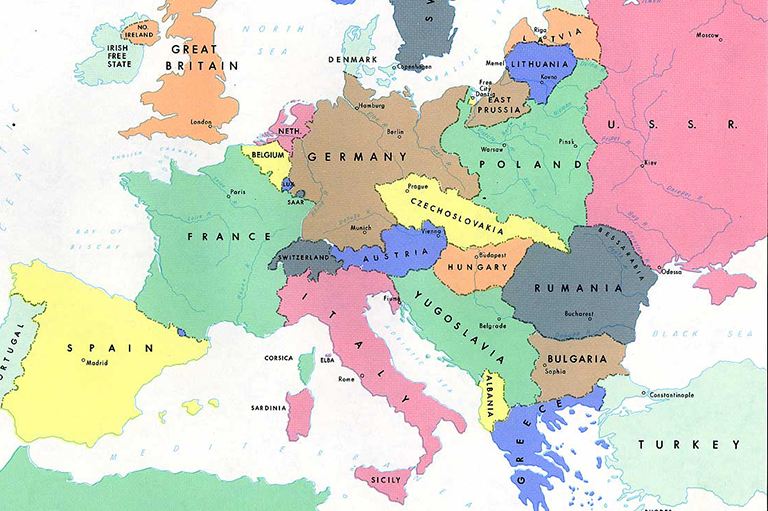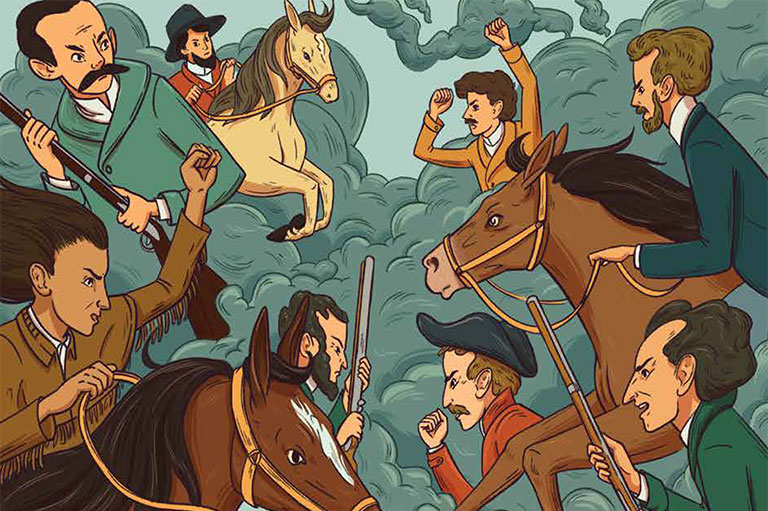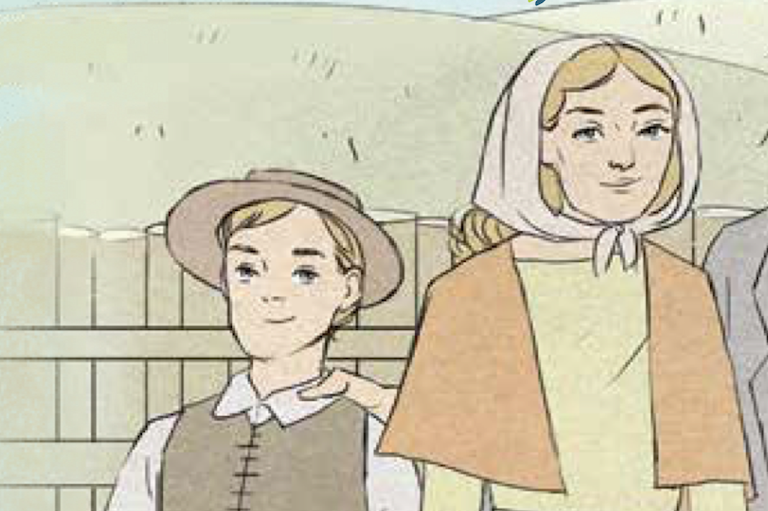Discover a wealth of interesting, entertaining and informative stories in each issue, delivered to you six times per year.
Sleeping Car Porters
Grade Levels: 5/6, 7/8, 9/10
Subject Area: Social Studies/History
This lesson plan is inspired by the article “Railway Men: Black Porters Stand Up for Fairness,” in the Black history in Canada issue of Kayak: Canada’s History Magazine for Kids (expanded in 2022) and History Bits video “Railway Men.”
Lesson Overview
In this lesson, students will analyze artifacts related to the Black sleeping car porters to gain a better understanding of the men’s daily lives and their contributions to the struggle for labour rights and human rights for Black Canadians.
Time Required
3-4 lessons
Historical Thinking Concept(s)
- Establish historical significance
- Use primary source evidence
- Identify continuity and change
- Analyze cause and consequence
- Take historical perspectives
Learning Outcomes
Students will:
- Comment on the political and social context of Black Canadians between 1900 and the Second World War
- Become familiar with working conditions of sleeping car porters before they became unionized
- Investigate primary source documents, images, and artifacts to build historical knowledge
- Make inferences about the artifacts relating to Black sleeping car porters
- Explain how Canada’s identity has been and continues to be shaped by its global participation
- Discuss the struggle for equal human rights by Black Canadians in the twentieth century to the present day
Background Information
The Pullman Palace Car Company established the Pullman porter position in 1867. George Pullman, the company owner, designed the Pullman sleeping car to provide luxury overnight travel service in the United States. Only a few years after the Emancipation Proclamation, Pullman’s porter workforce consisted entirely of freed Black men as they were a source of cheap and abundant labour. Working as a porter was one of the few gainful employment opportunities afforded to freed Black men in the late 19th and early 20th centuries. Whites, in general, accepted this approach because historically Blacks were stereotyped as servants. By the beginning of the 1900s, Canadian railway companies adopted the practice of using Black porters when the Pullman service expanded into Canada. At this time, railway companies were the largest employers of Black Canadian men in the country.
The porters’ job required them to leave their families for weeks at a time, receiving no more than three hours of sleep a night. That means they had a 21-hour workday! They were subjected to discimination within their jobs and from the people they served: porters could be fired without reason or recourse; they were called racially derogatory names; and most porters were nicknamed “George” by their customers, refusing to use their real names. This nickname was humiliating and degrading for porters, effectively removing their individuality and identity.
Black porters were also denied job promotions. Some wanted to join the newly established labour unions for White porters but were blocked from joining because of their race. As a result of this discrimination, in the 1920s some Black porters in the United States decided to organize their own trade union to fight for better working conditions and successfully formed the Brotherhood of Sleeping Car Porters (BSCP). In the early 1940s, Black porters in Canada began organizing with support and guidance from their American brothers to form their own union.
In 1942, the BSCP established divisions in Montreal, Toronto, Winnipeg, Calgary, Edmonton, and Vancouver. In May of 1945, the BSCP signed its first collective agreement with Canadian Pacific (CP) Rail. The agreement increased porters’ wages and their days off. The number of hours they worked each week was reduced. This was the first time in Canadian history that a trade union organized by and for Black men signed an agreement with a Canadian company.
The Lesson Activity
Activating: How will students be prepared for learning?
Watch the History Bits video “Railway Men” as a class. Alternatively, distribute the article “Railway Men” in the Black History in Canada issue of Kayak: Canada’s History Magazine for Kids (expanded in 2022) as a printout, on a laptop or other electronic device and read aloud as a class or have students read in small groups.
Start a group discussion with the class centred around these questions:
- What are some factors that allowed for this kind of racial discimination in the workplace?
- Can you think of other similar examples in history?
- Does this still happen in present day?
Acquiring: What strategies facilitate learning for groups and individuals?
- Students will work together in teams to learn about the job of porters through investigating a number of artifacts.
- Divide the class into groups of 4 or 5.
- Inform students that they are going to learn more about the Black porters in Canada. In their groups, they will investigate a number of sources to gather information about this job and the men who performed it.
You can print the artifacts/images or display them on a computer screen. Have the students examine the artifacts and answer the related questions together as a class. Alternatively, provide each group with a set of artifacts to examine and analyze.
Artifact 1 – A porter with two other employees at a stop during the tour of Sir Arthur Conan Doyle across Canada, 1914, Library and Archives Canada
- What type of artifact is it?
- What do you see? Tell students to begin their observation statement with “I see….”
- Based on your observations, where/when do you think this happened?
- What can the uniforms tell you about the job responsibilities for each person in the image?
- How can the uniforms help you to infer what the job responsibilities for each person in the image were?
Artifact 2 – Brotherhood of Sleeping Car Porters Plaque at Roundhouse Park, Heritage Toronto
- What type of artifact is it?
- What do you see? Tell students to begin their observation statement with “I see….”
- What do you think the significance of this plaque is?
Artifact 3 – Railway Porters and Their Union National Historic Event Plaque in the Windsor Station in Montreal, Quebec
- What type of artifact is it?
- What do you see? Tell students to begin their observation statement with “I see….”
- What do you think the significance of this plaque is?
Artifact 4 – Stanley Grizzle Name Train Car Sign
- What type of artifact is it?
- What do you see? Tell students to begin their observation statement with “I see….”
- Why would Black sleeping car porters see this name sign as important?
Artifact 5 – CPR Porters, Library and Archives Canada
- What type of artifact is it?
- What do you see? Tell students to begin their observation statement with “I see….”
- What can you infer about the relationship between the men in the image? Does it remind you of anything from the story you read?
Give each group a piece of chart paper or another large sheet of paper and markers. After students have explored the artifacts, ask groups to record what they have learned in a creative way. Regroup as a class. Check for understanding by asking questions. Teacher prompts may include:
- Where was the only place Black men could find stable work during the 1900s?
- What kinds of racial discrimination did the Black porters face? Why do you think this racism existed?
- How did the sleeping car porters challenge the racism they faced?
- What was the most surprising thing you learned about their job?
- What is the impact of Black porters being called “George”?
- Write down one question you still have about railway jobs.
Materials/Resources
- If you want to print images of these artifacts for your students, you can use this PDF.
- Artifact 1 – A porter with two other employees at a stop during the tour of Sir Arthur Conan Doyle across Canada, 1914, Library and Archives Canada
- Artifact 2 – Brotherhood of Sleeping Car Porters Plaque at Roundhouse Park, Heritage Toronto
- Artifact 3 – Railway Porters and Their Union National Historic Event Plaque in the Windsor Station in Montreal, Quebec
- Artifact 4 – Stanley Grizzle Name Train Car Sign
- Artifact 5 – CPR Porters, Library and Archives Canada
- My Name’s Not George: The Story of the Brotherhood of Sleeping Car Porters in Canada, by Stanley Grizzle with John Cooper, Umbrella Press, 1998.
- A Long Hard Journey: The Story of the Pullman Porter, by Patricia and Fredrick McKissack,” Walker & Co., 1989.
- North of the Color Line: Migration and Black Resistance in Canada, 1870-1955, by Sarah-Jane (Saje) Mathieu, University of North Carolina Press. 2010
- A Struggle to Walk with Dignity: The Story of a Jamaican-born Canadian, by Gerald A. Archambeau, Dundurn, 2008.
- The Road Taken, National Film Board, 1996.
- Sleeping Car Porters, Black Strathcona
- Sleeping Car Porters, Canadian Museum for Human Rights
- Brotherhood of Sleeping Car Porters
- “North of the Colour Line: Sleeping Car Porters and the Battle Against Jim Crow on Canadian Rails, 1880-1920,” Labour/Le Travail, 47 (Spring 2001), p.9-41 by Sarah-Jane (Saje) Mathieu
Extension Activity
- Individually, or in small groups, use the suggested resources to conduct further research on the experiences of Black sleeping car porters and their participation in the struggle for labour rights and human rights. Write an editorial letter to a major newspaper explaining the views and goals of the Brotherhood of Sleeping Car Porters.
- Use a timeline app to create a timeline that depicts the history of the sleeping car porters in Canada.
Assessment
- Assess students’ editorial or timeline.





